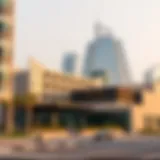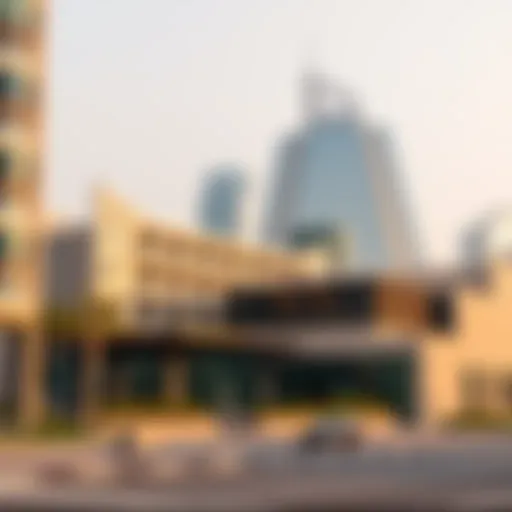Exploring Dubai Creek and Golf Club's Impact
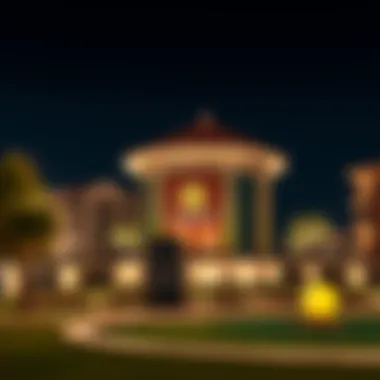

Intro
Nestled within the heart of Dubai, the Dubai Creek and the Dubai Golf Club stand as testaments to the emirate's mix of tradition and modernity. This region not only serves as a picturesque destination for leisure and sporting enthusiasts but also represents a crucial pivot in Dubai's real estate market. As potential buyers and investors explore opportunities here, understanding the intertwined narratives of these landmarks becomes essential.
The historical significance of Dubai Creek dates back centuries, acting as a vital lifeline for trade and commerce. Conversely, the Dubai Golf Club, an architectural gem with a lush green landscape, caters to a sport often associated with luxury and exclusivity. Together, these sites symbolize Dubai's rapid evolution, shaping not just its skyline but also the economic prospects for property investment around them.
As we navigate through the intricate pathways of this article, we will uncover key insights into the real estate dynamics influenced by the presence of these iconic sites. From exploring current market trends to identifying hot neighborhoods ripe for investment, our journey aims to equip savvy investors and homebuyers with a comprehensive understanding of where to stake their fortunes in this flourishing landscape.
Prelude to Dubai Creek
Dubai Creek, a vital artery of the city, serves as a picturesque backdrop for both locals and visitors. It embodies the rich history and dynamic growth of the region. The importance of this waterway goes beyond mere aesthetics; it is a symbol of the economic and cultural heartbeat of Dubai. Understanding Dubai Creek provides critical context for discussing its impact on the surrounding real estate market as well as its role in tourism and economic development. The blend of history, geography, and cultural significance establishes a solid foundation for comprehending the overall atmosphere of this vibrant area.
Historical Overview
Dubai Creek has been a lifeline for commerce since its early days. Its history is steeped in the trade of pearls and spices, crucial commodities in establishing Dubai as a trading hub. From the mid-19th century, when the creek became a port for trading vessels, to today, it has constantly evolved while keeping its historical significance intact. Notably, the creek transformed into a center where traditional dhows still sail, providing a glimpse into the past amidst modernity.
Also, in the 1960s, the establishment of the Dubai Customs Office on its banks added a layer of administrative importance. This marked the inception of organized trade and regulation, ensuring that the creek remained central to Dubai's economic activities.
For those interested in real estate and investment opportunities, the historical depth of Dubai Creek provides a perspective on its continual growth and development. It speaks volumes about both the resilience and adaptability of the region.
Geographical Features and Significance
Geographically, Dubai Creek stretches approximately 15 kilometers and divides Dubai into two main sections: Deira to the north and Bur Dubai to the south. The creek's shallow waters are navigable and lined with an array of facilities, from traditional souks to luxury hotels. Its mixed-use areas cater to both business activities and leisure pursuits, making it an attractive site for potential investments.
Moreover, the surrounding landscape has been thoughtfully developed to incorporate parks, promenades, and gazebos, which enhance the area’s livability. This blend of nature and urban development has turned Dubai Creek into a focal point for tourism, making it essential for real estate professionals to consider these aspects when evaluating future endeavors.
"Dubai Creek is more than just water; it’s where history meets modernity, and every wave tells a story."
Cultural Importance of Dubai Creek
The cultural significance of Dubai Creek stretches far beyond its scenic vistas and tranquil waters. This waterway is not just a geographical feature; it is a living narrative woven into the cultural fabric of Dubai. The Creek has been a vital artery for trade, transportation, and interaction, shaping the identity of the Emirate. Delving into its cultural essence offers insights into the traditional practices and the burgeoning modern lifestyle of the Emirate. The blend of old and new is so palpable around the creek, making it a focal point for understanding the evolution of Dubai as a major global player.
Traditional Trade and Economy
Historically, Dubai Creek served as the lifeblood for the local economy. The waters were bustling with dhows, traditional wooden trading vessels that carried goods like spices, textiles, and pearls from various corners of the world. Today, remnants of that vibrant trading history still exist along the shore, where souks invite locals and tourists to immerse themselves in the rich aromas of spices and the vibrancy of handicrafts.
- Trade Significance: The Creek was pivotal for early merchants, establishing Dubai as a trading hub. Its strategic location allowed for easy access to the Persian Gulf, fostering relationships with regions such as Asia, Europe, and Africa.
- Economic Evolution: As the economy diversified, the Creek transitioned from a source of income centered around fishing and trading to a focus on tourism and real estate. Periodically, it acts as a reminder of how far the city has come and the potential avenues for further economic development.
The Dubai Creek is more than just a waterway; it is a historical canvas where trade, culture, and community converge, embodying the spirit of entrepreneurialism that the region is known for.
Cultural Festivals and Events
Through the years, the area surrounding Dubai Creek has hosted numerous festivals that connect people with their heritage. These events highlight both traditional and contemporary Emirati culture, reinforcing the community’s identity.
- Cultural Celebrations: Annual events like the Dubai Shopping Festival reflect how the Creek remains a central hub for cultural exchange. This festival attracts both residents and visitors, featuring performances, food exhibitions, and music that showcase Emirati traditions blended with global influences.
- Heritage Festivals: Activities focused on traditional crafts and local cuisine help educate younger generations about their roots. Such festivals not only celebrate the past but also bridge cultures and attract a diverse audience fascinated by Emirati customs.
- Engagement in Community Events: Local parks and venues near the Creek regularly host workshops, art exhibitions, and educational programs aimed at fostering a sense of community pride and awareness.
As these cultural events unfold, they keep the spirit of Dubai Creek alive, ensuring that it remains an avenue not just of trade or tourism, but also of cultural continuity and community engagement. This significance emphasizes the multifaceted role the Creek plays in the lives of those who live nearby and visit.
Architectural Marvels Along Dubai Creek
Dubai Creek is more than just a body of water; it is a cultural vein coursing through the heart of the city, showcasing a dynamic blend of modernity and tradition through its architectural landmarks. As we examine the architectural marvels along the creek, we gain insight into the vision that shaped contemporary Dubai while also reflecting on the historical narratives that remain etched in its core. This juxtaposition makes the area not just a picturesque landscape but also a significant hub for real estate investment, cultural appreciation, and heritage conservation.
Modern Developments
In recent years, Dubai Creek has witnessed a flurry of modern architectural projects aimed at enhancing the visual appeal and function of the waterfront. One notable example is the Dubai Creek Tower, which, once completed, promises to redefine the skyline, boasting an ambitious height that challenges global standards. Designed to surpass the Burj Khalifa, this tower encapsulates the spirit of innovation synonymous with Dubai.
Another critical development is the Dubai Creek Harbour project. It's intended to be a mixed-use community that combines both residential and commercial spaces. This project is strategic, offering numerous amenities tucked away just on the banks, making it attractive for families and investors alike. Here are some specifics about the modern developments along Dubai Creek:
- Architectural Diversity: A variety of designs contribute to a visually stimulating experience, including both ultra-modern skyscrapers and eco-friendly designs.
- Integration with Nature: Many of these developments emphasize outdoor spaces, promoting a lifestyle that celebrates nature, which complements the serene vibes of the creek.
- Sustainability Focus: Green building technologies infuse modern architecture with sustainability principles, ensuring that the growth of Dubai respects its environmental responsibilities.
Historical Landmarks
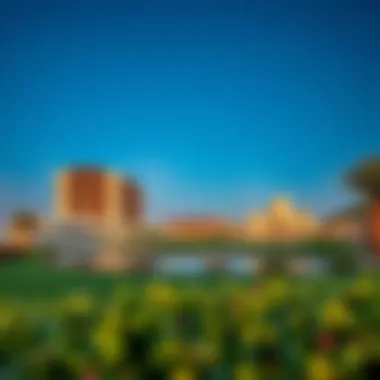

While modernity takes center stage, the historical landmarks along Dubai Creek cannot be overshadowed. Sites such as the Dubai Museum, housed within the Al Fahidi Fort, provide a stark contrast to the shimmering glass and steel structures that frame the skyline. This fort, dating back to 1787, is a testament to the area's rich history, showcasing Dubai before its transformation into a global metropolis. Here’s what makes these historical landmarks incredibly valuable:
- Cultural Significance: Each landmark tells a story of the past, offering insights into the traditions and lifestyles of early Emiratis, which adds depth to the modern urban landscape.
- Tourism Magnet: These historical sites attract both locals and tourists, enhancing the economic fabric of the region and converting the area into a leisurely paradise.
- Preservation Efforts: Significant investment is pouring into the conservation of these sites, ensuring they remain part of the urban narrative while allowing future generations to engage with their heritage.
"The architectural tapestry along Dubai Creek is a vibrant representation of the march of time—from its traditional roots through to its modern aspirations."
Prelims to Dubai Golf Club
The Dubai Golf Club is more than just a venue for hitting a few balls around the green; it's a cornerstone of the region's golf culture and a significant contributor to Dubai's economy. With its striking design that blends luxury with tranquility, it serves as a meeting point for locals and tourists alike. This section aims to provide an insightful peek into both the history and the unique characteristics that make the Dubai Golf Club a noteworthy highlight of the city.
History and Establishment
Established in 1993, Dubai Golf Club was envisioned as a premier destination that marries leisure and sport, providing an exceptional golfing experience. The founding of the club was emblematic of the ambitions surrounding Dubai's rapid growth during the 1990s. As a joint effort between the Emirates Golf Federation and the Dubai government, the club has so far weathered the ups and downs of the economy, always emerging stronger and more vibrant.
The initial layout was expertly crafted to incorporate the natural beauty of the desert landscape. Early on, the course was designed to challenge golfers of all skill levels while maintaining a visually stunning aesthetic. While its roots may stem from the ambition to foster a golfing community, over the years, it has grown to symbolize a hub of social activity, attracting golfers not only from the UAE but across the world. The golf club has not only flourished in terms of membership but also has paved the way for subsequent developments that echo its ethos.
"Golf is a game of a lifetime, and Dubai Golf Club has become a staple for both enthusiasts and casual players in this thriving city."
Course Design and Features
The layout of the Dubai Golf Club is intriguing, woven into the very fabric of the surrounding landscape. Spanning over 7,000 yards, the 18-hole championship course exemplifies precision planning. Renowned course designers, including the notable designer Karl Litten, have contributed to the course's evolution, ensuring it meets international tournament standards.
Key features of this well-manicured course include:
- Strategic Water Hazards: With several lakes and ponds, the course strategically integrates water hazards that put players’ skills to the test, adding an extra layer of challenge for golfers looking to lower their handicap.
- Undulating Greens: Fast and undulating greens require skillful putting, and they often become a talking point among passionate golfers who have encountered their twists and turns.
- Diverse Landscapes: Each hole offers a unique perspective, framed by palm trees and desert flora, turning a round of golf into a picturesque journey.
This design not only encourages competition but fosters camaraderie among members and visitors, promoting a thriving social scene. Moreover, the Dubai Golf Club frequently hosts high-profile tournaments, garnering interest from both local and global communities, thereby enhancing the region's reputation in the sports tourism industry.
With an unyielding focus on quality and experience, Dubai Golf Club sets a standard that resonates throughout the area, demonstrating how a well-curated sporting facility can drive economic growth while maintaining community focus.
In the next sections, we will further explore the interplay between this iconic institution and its surrounding real estate landscape.
Economic Impact of Dubai Golf Club
The economic ripple effects of the Dubai Golf Club are significant, extending beyond its green lawns and pristine courses. This sporting venue serves as a pivotal hub that intertwines leisure, investment, and community enrichment, contributing to the broader economic tapestry of Dubai. Understanding its economic impact sheds light on both immediate benefits and long-term ramifications for various stakeholders involved.
Tourism and Hospitality
Tourism is a cornerstone of Dubai’s economy, and the Dubai Golf Club plays a crucial role in attracting visitors from around the globe. The club not only hosts local golf tournaments but also international events, enticing golf enthusiasts and spectators alike. These events stimulate local businesses, from hotels to restaurants, creating a vibrant atmosphere that promotes cultural exchange and economic vitality.
- Golf Tournaments: Events such as the Dubai Desert Classic draw in crowds, leading to fully booked hotel rooms in the vicinity. The influx of tourists for these competitions requires substantial services and amenities.
- Hospitality Sector Growth: Many upscale hotels near the golf club cater specifically to golf tourists, creating tailored packages that enhance their experience. Furthermore, local eateries thrive on the increased foot traffic, benefiting from both daytime and evening clientele.
"The golf club isn’t just a place to play; it’s a catalyst for robust economic interactions that benefit the whole region."
Local transportation services also see an uptick, with golf packages often including shuttle services from hotels to the club. This further illustrates how interconnected the golf club is with Dubai’s hospitality offerings. The ramifications extend beyond just dollars and cents; they encapsulate the essence of community engagement and the fostering of relationships among diverse groups.
Investment Opportunities
The allure of the Dubai Golf Club isn’t limited to tourism alone; it opens a treasure trove of investment opportunities in real estate and related ventures. For prospective investors, the proximity to such a prestigious location offers a compelling proposition.
- Real Estate Development: Residential projects surrounding the golf course are highly sought-after. Homes that offer golf course views command premium prices and have a robust resale value. Investors can confidently pour resources into such developments, knowing that they attract both local buyers and expatriates looking for elegant living spaces.
- Commercial Ventures: The area surrounding the golf club is ripe for commercial enterprises. Retail shops, wellness centers, and fine dining options are all desirable additions that can service the growing demand from residents and visitors alike. Investors with a keen eye for opportunity can explore partnerships or ventures that would flourish in this emerging market.
Additionally, with Dubai’s strategic vision for becoming a leading global city, investment around the Dubai Golf Club is increasingly perceived as a wise financial move. With population growth and urban expansion, laying the groundwork now may lead to significant returns in the future.
In summary, the Dubai Golf Club serves as a beacon for economic opportunity, reflecting a vibrant synergy between tourism, hospitality, and real estate investments. The narratives woven through these interactions unveil a multifaceted economic picture, indicating that involvement in this sphere can lead to sustainable growth and community prosperity.
Real Estate Trends Surrounding Dubai Creek
The landscape of real estate around Dubai Creek is more than just a hot market; it's a dynamic ecosystem that shapes the future of the emirate itself. The increasing desirability of properties here comes from a blend of cultural significance, strategic location, and the scenic beauty of the area. Investors and homebuyers looking to engage with this market must understand the ongoing trends and shifts, which can provide both opportunities and challenges.
High-Demand Properties
Within the vicinity of Dubai Creek, certain properties are attracting considerable attention, and for good reason. Proximity to vital amenities, breathtaking views, and rich history make these areas prime spots for both investment and residence. Some of the notable high-demand properties include luxury apartments, waterfront townhouses, and villas that offer easy access to the Creek.
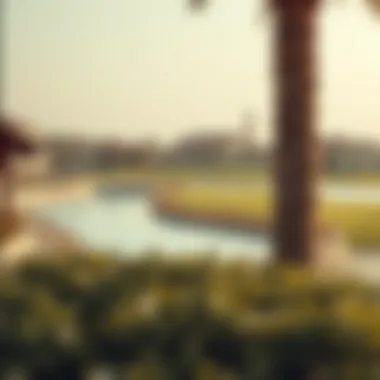

- Luxury Waterfront Apartments: Many buyers are captivated by the modern design and stunning views these apartments offer. For instance, developments like Dubai Creek Harbour are redefining urban living, with state-of-the-art facilities and recreational spaces.
- Mixed-Use Developments: Properties that blend residential, commercial, and leisure spaces have seen a surge in interest. Buyers appreciate the convenience of having various amenities at their doorstep. These developments lead to vibrant communities with a lively atmosphere.
- Cultural Heritage Sites: Properties near historical landmarks, such as the Dubai Museum and the Sheikh Mohammed Centre for Cultural Understanding, attract both locals and expatriates. These homes often come with a narrative that appeals to those wanting a connection to the region’s past.
The demand for these properties is driven not just by housing needs but also by a lifestyle that many associate with luxury and convenience. With a steady influx of expatriates and tourists, this segment of the market is likely to continue thriving.
Emerging Neighborhoods
As Dubai continues to evolve, several neighborhoods surrounding Dubai Creek are emerging as attractive destinations for savvy investors. The push for development projects has transformed once quiet or underdeveloped areas into bustling hubs. Understanding these emerging neighborhoods can provide insights into future real estate opportunities.
- Al Jadaf: This area is becoming increasingly popular due to its strategic position and ongoing revitalization projects. The area is slated for a significant urban development plan, introducing parks, shopping districts, and cultural centers. Investing now could yield fruitful returns as gentrification takes place.
- Riyadah: Located along the banks of the Creek, Riyadah is witnessing new residential construction. The zoning policies are favorable, making it appealing for both developers and buyers looking for spacious living that rivals the traditional high-rise apartments.
- Bur Dubai: With its rich heritage and upcoming infrastructure enhancements, Bur Dubai is gaining traction. The traditional architecture blends well with modern developments, offering a unique living experience that's rooted in local culture.
These neighborhoods are ripe for solid investments as they benefit from both evolving local policies and burgeoning demand. Investing in areas with the potential for growth can be prudent, especially given their proximity to essential amenities and their role in Dubai's broader urban strategy.
Overall, the relationship between real estate and Dubai Creek is multifaceted and compelling. Understanding the high-demand properties and emerging neighborhoods surrounding the Creek serves as a conduit for informed investment decisions. The future of this area looks promising, making it a focal point for both seasoned and novice investors.
The Role of Luxury Developments
Luxury developments in the vicinity of Dubai Creek and the Dubai Golf Club serve as linchpins in the overall growth narrative of the area. The importance of these high-end projects goes beyond mere opulence; they intertwine with the cultural fabric, economic stability, and environmental sustainability of the region. Investors not only see them as beautiful properties but as viable opportunities for substantial returns.
Luxury projects attract a specific demographic, often consisting of expatriates and affluent individuals seeking premium living standards. These developments contribute significantly to the local economy, enhancing tourism while simultaneously stimulating job generation in sectors such as real estate, hospitality, and retail. Moreover, luxury offerings bolster the overall perception of Dubai as a premier lifestyle destination, thereby increasing its global stature.
Residential and commercial developments are vital tools for engaging with the market and raising the region's profile as a high-value investment area. They cater to individuals whose lifestyles are in sync with the trappings of affluence. Here, we will explore the particulars of residential and commercial luxury projects, focusing on their unique attributes and impacts.
Residential Projects
Residential projects along Dubai Creek and near the Dubai Golf Club are designed to resonate with buyers who prioritize exclusivity and ultramodern amenities. These properties feature state-of-the-art facilities, spacious layouts, and stunning views of either the waterway or verdant golf courses. Examples include upscale apartment complexes with private pools, yoga spaces, gyms, and concierge services that ensure convenience.
The architectural designs often incorporate elements that celebrate the local culture while embracing contemporary aesthetics, making them functional landmarks in their own right. The likes of Dubai Creek Residences and Ritz-Carlton Residences exemplify how luxury living can seamlessly integrate with nature and urban sophistication.
Notably, the demand for luxury residential spaces is driven by several factors:
- Accessibility: Proximity to leisure, dining, and cultural attractions makes these properties especially appealing.
- Security: Residents often appreciate enhanced security features, a key selling point in high-end developments.
- Investment Value: With the trend of luxury properties appreciating over time, many buyers see them as sound investment choices.
Commercial Ventures
Unlike residential projects that focus on personal comfort, commercial luxury developments are centered around business needs and cater to upscale clientele. Here, the emphasis is on creating spaces that not only look good but function well for various business enterprises.
From high-end office spaces to luxury retail outlets and hotels, commercial ventures enhance the area’s economic landscape. Companies like Al Habtoor Group and Emaar Properties are leading the charge, establishing premium business facilities that offer more than just a place to work.
Such developments have a significant impact on the local economy by:
- Attracting Investments: Investors are drawn by the prestige associated with luxury brands, leading to more funding and commercial activity.
- Creating Job Opportunities: Establishing businesses in luxury spaces leads directly to job creation, from management to support staff roles.
- Enhancing Customer Experience: Tailored services and exclusive experiences are designed specifically for high-net-worth individuals, thus elevating their interaction with Dubai as a whole.
"Luxury is not a necessity but a right for many. The role of luxury developments reflects a commitment to not just real estate but to culture and lifestyle enhancement."
Comparative Analysis: Dubai Creek vs. Dubai Golf Club
When exploring pivotal areas within Dubai, a comparative analysis of Dubai Creek and the Dubai Golf Club comes into play. Understanding the unique offerings of each can shape an investor's or buyer's approach to real estate in the region. Both sites boast distinct characteristics that blend historical allure with modern luxury, catering to diverse segments of the market.
Visitor Demographics
Diving into the visitor demographics, we find a compelling contrast between Dubai Creek and the Dubai Golf Club. On one hand, Dubai Creek attracts a broad audience, from local families enjoying weekend picnics to tourists enamored by its historical significance. The majority of visitors are often interested in the cultural experiences that the Creek offers, such as traditional abra rides and visits to the local souks. This aspect makes the Creek a hub of cultural engagement, drawing families, history buffs, and international tourists alike.
In contrast, the Dubai Golf Club tends to appeal more to a niche market, specifically affluent individuals and corporate entities. Golf enthusiasts are its lifeblood, including international professionals, who view the club not just as a place to play golf but as a venue for networking and business discussions amidst a picturesque environment. The demographic here skews toward middle-aged to older adults, with disposable income and a penchant for leisure activities that foster both enjoyment and business connections.
Impact on Local Economy
The economic ramifications associated with both destinations cannot be overstated. Dubai Creek is a cornerstone of tourism in the area, heavily contributing to the local economy through retail and hospitality. Small businesses thrive along the waterfront, providing everything from traditional crafts to modern cuisine. The influx of visitors promotes job creation, particularly in the service sector, where a diversity of roles from hospitality to guiding is always in demand.
Conversely, the Dubai Golf Club impacts the economy through a different lens. It attracts a more affluent segment of the population, suggesting a higher average spending per visit. Beyond playing golf, patrons engage with luxury dining and leisure facilities, thereby enhancing the city’s upscale hospitality offerings. Investment opportunities flourished here; the club not only attracts tourists but also encourages the development of real estate properties nearby, fostering a high-end living standard that aligns with the UAE's vision to be a global hub for luxury.
It’s clear that while Dubai Creek nurtures roots of cultural tourism, the Dubai Golf Club underscores high-end leisure and its associated economic benefits.
In summary, contrasting visitor demographics and their respective impacts on the economy reveal that Dubai Creek and the Dubai Golf Club play vital, yet differing roles in shaping Dubai's vibrant landscape. Investors, buyers, and stakeholders within the real estate domain ought to consider these nuances when assessing opportunities around these key locations.
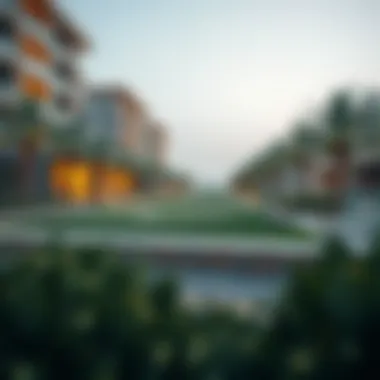

Sustainability Initiatives in Dubai Creek and Golf Club
When discussing the ongoing transformations in urban landscapes, sustainability initiatives play a pivotal role, particularly in areas like Dubai Creek and the Dubai Golf Club. Both locations have become focal points not merely for recreation and hospitality but also as models for environmentally conscious development. This section delves into how these initiatives manifest and the far-reaching implications they hold for the future of real estate and ecotourism in the region.
Environmental Contributions
Dubai Creek and the adjoining Golf Club are exemplary in integrating sustainability within their operations and development plans. One noteworthy aspect is the implementation of smart irrigation systems that conserve water. These systems utilize sensors and weather data to optimize water usage, ensuring that irrigation is only performed when needed. This proactive measure has not only reduced water wastage significantly but also created healthier landscapes for both residents and wildlife.
Furthermore, the areas have invested in renewable energy sources. Solar panels adorn various facilities, generating clean energy that powers everything from the golf club's amenities to the lighting along the creek. Such efforts not only mitigate the carbon footprint but also showcase how large-scale developments can lead in adopting renewable solutions.
Additionally, landscaping choices at Dubai Golf Club focus on native plants that thrive in the local climate. By minimizing the need for synthetic fertilizers and pesticides, these initiatives contribute to pollution reduction and biodiversity preservation. Healthy ecosystems are vital, and their presence aids in sustaining local wildlife, from birds to small mammals that call this region home.
"Sustainability isn’t just a buzzword; it’s a blueprint for the future we want to cultivate in our urban surroundings."
Community Engagement
Another layer to the sustainability narrative involves community engagement. The golf club and surrounding areas have been proactive in fostering a culture of environmental awareness. Workshops and community programs centered around sustainability have been established, drawing in locals and visitors alike. These initiatives educate participants about ecological preservation, resource management, and the simple practices they can adopt in their daily lives.
Furthermore, local partnerships with NGOs aim to involve the community in conservation efforts. Initiatives like tree planting drives along Dubai Creek bring people together for a common cause, enhancing community spirit while bolstering ecological health. Events such as clean-up drives along the creek not only beautify the area but also instill a sense of collective responsibility among residents and visitors.
Moreover, youth involvement has been encouraged through educational programs. Schools often collaborate with the golf club to instill environmentally friendly practices in younger generations. Engaging students in sustainable gardening, water conservation, and wildlife studies highlights the importance of nurturing awareness from a young age.
These community-centric approaches further promote a holistic view of sustainability, extending beyond the economic aspects to emphasize environmental and social dimensions. In the long run, such comprehensive engagement can reshape perceptions and foster a greener future for Dubai and its renowned landmarks.
Future Prospects for Development
As the world pivots towards more sustainable and inclusive urban landscapes, Dubai Creek and the Dubai Golf Club stand poised at the forefront of these transformations. Understanding the future prospects for development in this area isn’t just an exercise in speculation. It’s an exploration of potential and an understanding of how various initiatives can reshape the economic and cultural fabric of the city. From infrastructural upgrades to community-driven projects, these prospects are critical for investors, developers, and citizens alike.
The importance of this topic lies in the strategic positioning of Dubai Creek and its adjacent golf club as more than mere recreational or scenic spots. They serve as a nucleus of economic activity and a testament to Dubai's ambitions on the global stage. There are multiple projects lined up that will enhance the appeal of this region, promising benefits such as increased tourism access, better amenities for residents, and a greater influx of foreign investments. To navigate the complex landscape of opportunities, it is vital for stakeholders to have a nuanced understanding of these developments.
Planned Projects and Extensions
Several ambitious initiatives are currently in the pipeline for Dubai Creek and the accompanying golf club. These projects are intended not just to enhance recreational opportunities but to create a thriving ecosystem where business, leisure, and residential life intertwine seamlessly.
- Mixed-use Developments: Plans for mixed-use complexes that combine residential, commercial, and recreational facilities are in the works. This kind of development aims to create a vibrant community where residents can access various services within walking distance.
- Transportation Infrastructure: Enhancements to public transportation routes, including possibly extending water taxis and other methods of transport, are being discussed. This will improve accessibility to both the Creek and Golf Club, making them pivotal in the broader transport network of Dubai.
- Eco-friendly Initiatives: There is an increasing shift towards sustainability, driving projects aimed at environmental conservation and energy efficiency. Efforts such as green parks and solar-powered facilities reflect a growing commitment to ecological responsibility.
These developments provide a glimpse into a future where Dubai Creek and the Golf Club are not just tourist attractions but integral parts of a livable, sustainable urban landscape.
Long-term Investment Strategies
Investing in Dubai Creek and the Golf Club requires a strategic approach, as the future seems to hold considerable promise. Understanding the ins and outs of long-term investment strategies is essential for real estate agents, investors, and homebuyers looking to capitalize on emerging opportunities.
- Diversification of Investment: It’s wise to consider a mix of property types—residential, commercial, and retail—within the vicinity of these sites. This not only spreads risk but also caters to a broader demographic, from families to business professionals.
- Focus on Utilities and Amenities: Properties that prioritize easy access to amenities such as schools, hospitals, and shopping centers will likely appreciate more quickly. Advisors and developers should promote these aspects when targeting potential buyers.
- Market Trends Analysis: Continuous monitoring of real estate trends, economic indicators, and demographic shifts helps in making informed decisions. Utilizing resources from local governments and market reports can provide insight into future developments that might affect valuations.
These strategies highlight an essential consideration: successful investments hinge not solely on current market conditions but also on foresight and adaptability to change.
"Investors should keep an eye on the developments around Dubai Creek, as they can define the real estate landscape for years to come."
Closure
In wrapping up our exploration of Dubai Creek and the Dubai Golf Club, it becomes clearer than ever how these two landmarks intertwine with the fabric of Dubai's culture, economy, and real estate landscape. This connection is not just superficial; it's deeply rooted in the history of the region and its ongoing evolution.
Summary of Key Insights
The insights gathered throughout this discussion highlight several critical elements:
- Cultural Heritage: Dubai Creek has long served as the heart of trade and cultural exchange. Its historical significance cannot be overstated as it has shaped the economic landscape of Dubai.
- Architectural Wonders: The architectural features found along the Creek juxtapose modern designs with traditional styles, creating a unique skyline that attracts both tourists and investors.
- Investment Potential: The Dubai Golf Club exemplifies how recreational facilities can influence property values and spur economic growth. Its existence adds a layer of luxury that appeals to high-end buyers.
- Sustainability and Future Growth: Both Dubai Creek and the Golf Club are stepping into a future driven by sustainability and community involvement, aligning with global trends towards eco-friendly developments.
Final Thoughts on Investment Viability
When considering the investment landscape surrounding these key sites, several factors play a pivotal role:
- High Demand: With an increase in tourism and expatriate population, the demand for residential and commercial properties around Dubai Creek remains strong.
- Strategic Location: Being close to iconic landmarks positions properties for appreciation, making them worthy of investor considerations.
- Evolving Market: As Dubai continues to evolve, so does the potential for investment in emerging neighborhoods and luxury developments.
- Government Initiatives: The local government’s push for innovation and modernization paves a promising path for future projects, making investments more appealing.
Ultimately, the juxtaposition of historical significance and modern luxury at Dubai Creek and the Golf Club forms an intriguing narrative for potential investors, reinforcing the notion that investing in these areas is not just a monetary decision but a chance to be part of a burgeoning legacy.
"The past, present, and future of Dubai's real estate are all encapsulated within the embrace of the Creek and the Golf Club."
In summary, both sites exemplify the unique blend of culture and commerce that defines Dubai, making them critical focal points for any investor or homebuyer looking to navigate the ever-evolving landscape of real estate in the region.
